Typology-Driven Urban Community Resilience Assessment in China: Spatial Disparities and Smart Transformation Roadmaps
Abstract
1. Introduction
1.1. Community Resilience: Concept and Inclusions
1.2. Community Resilience Assessments
1.3. Characteristics of Chinese Urban Communities
2. Materials and Methods
2.1. The Case Study Area
- (1)
- Old residential complex (X1): These areas typically consist of housing built before the 2000s, with most constructed between the 1970s and the 1990s. Some originated from public housing projects funded by the government or work units in the previous century. Compared to complexes developed after the housing reform, these are significantly older. They mainly feature traditional multi-story buildings, are generally large in scale, and have smaller floor areas.
- (2)
- Tower block apartments (X2): Predominantly constructed in the 1990s, these complexes emerged from gradual changes in national housing policies and the rise of high-rise residential buildings in major cities following the reform and opening-up. Unlike contemporary high-rise buildings, tower apartments usually consist of one or a few high-rise blocks. Although the overall land use is not extensive, it contains numerous housing units. They are situated on independent plots with entrances facing the street and are often located in central urban areas.
- (3)
- Commodity housing estate (X3): These are residential communities developed and sold through formal channels since housing reforms. Built more recently, they incorporated advanced planning concepts, focusing mainly on medium and high-rise buildings, with relatively high floor area ratios and comprehensive supporting facilities.
- (1)
- Central urban communities (Y1) typically occupy the core of the city, often encompassing the central business district, major cultural institutions, and historical landmarks. These areas are characterized by high population density, diverse economic activities, and well-developed infrastructure.
- (2)
- Subcentral urban communities (Y2) form a transitional zone between the core and outskirts, often featuring a mix of residential and commercial areas with varying degrees of urban development and population density.
- (3)
- Peripheral urban communities (Y3), situated at the outer edges of the city, exhibit distinct characteristics compared to their central and subcentral counterparts. These areas may include suburban developments, industrial zones, or even with some semi-rural landscapes that transit into urban spaces. Peripheral communities often experience rapid growth and transformation as cities expand outward, leading to challenges in infrastructure development, service provision, and maintaining a balance between the urban and natural environments.
2.2. Development of Community Resilience Framework and Indicators
2.3. Data Collection
2.4. The Weighing Methods
3. Results
3.1. The Descriptive Statistics of the Surveyed Community Cases
3.2. The Weights of Indicators and the Overall Performance Score
3.3. Comparing Three Types of Communities by Resilience Dimensions
3.3.1. Environmental Resilience
3.3.2. Service Resilience
3.3.3. Social Resilience
3.3.4. Governance Resilience
- (1)
- Tower apartments: This community type exhibits the highest overall resilience (X = 0.511). Constructed mainly between the 1990s and the 2000s, these buildings were predominantly located at the heart of Tianjin. Compared to the other two community types, tower apartments generally show strong resilience in both service and social aspects. Their resilience is bolstered by the optimal utilization of nearby resources and excellent access to surrounding public services, fulfilling residents’ daily requirements. Consequently, their overall resilience was relatively robust. However, many of these structures are old and require extensive renovation and upgrades, making them a key target for future community renewal and governance efforts. The governance system is also weaker in areas such as social organizations, neighborly interactions, and public engagement.
- (2)
- Old residential complexes: These communities have a low overall resilience level (X = 0.424). While community governance resilience is relatively high, the resilience of the built environment and public service facilities is low. These communities are often marked by significant aging, primarily consisting of workplace compounds with large land coverage, enclosed layouts, and a notable lack of multifunctional facilities. Additionally, these communities typically experience high rental rates, strong population mobility, and relatively high willingness among residents to relocate. Nonetheless, their overall cohesion and sense of community belonging remained fairly strong. Future resilience improvements should focus on enhancing infrastructure and updating the spatial environment. Improving the interactive relationships among various neighborhood life circle spaces is essential.
- (3)
- Commodity housing estates: These communities generally have a moderate level of overall resilience (X = 0.488), particularly in terms of environmental and governance resilience. These communities feature newly planned spatial layouts, well-equipped infrastructure, and professional property management. Nevertheless, because of their vast size and relatively distant location, access to facilities is limited. For these communities, future enhancements should focus on boosting public-service offerings and improving accessibility. It is crucial to optimize the availability of daily service facilities, expand the reach of convenience stores through both online and offline channels, and strengthen express delivery and logistics capabilities at the entry and exit points.
3.4. Regional Differentiation
4. Discussion
4.1. Exploring Resilience Enhancement Strategies Towards Targeted Measures
4.2. Promotion Systems and Implementation Pathways
- (1)
- Protect vulnerable groups and promote social equity and justice
- (2)
- Respond to changing risks and strengthen infrastructure
- (3)
- Address social needs and create economic and employment opportunities
4.3. Establishing a Resilience Monitoring Platform Towards Smart Governance
5. Conclusions
6. Limitations
Supplementary Materials
Author Contributions
Funding
Data Availability Statement
Conflicts of Interest
References
- Keating, A.; Hochrainer-Stigler, S.; Mechler, R.; Laurien, F.; Rubenstein, N.; Deubelli, T.; Velev, S.; Szönyi, M.; Nash, D. Reflections on the Large-Scale Application of a Community Resilience Measurement Framework across the Globe. Clim. Serv. 2025, 38, 100562. [Google Scholar] [CrossRef]
- Norris, F.H.; Stevens, S.P.; Pfefferbaum, B.; Wyche, K.F.; Galea, S. Community resilience as a metaphor, theory, set of capacities, and strategy for disaster readiness. Am. J. Community Psychol. 2008, 41, 127–150. [Google Scholar] [CrossRef] [PubMed]
- Walker, A.; Alebon, K.; Klinsky, S. Local Governments’ Response to Agenda 21: Summary Report of Local Agenda 21 Survey with Regional Focus. Available online: https://www.ircwash.org/sites/default/files/Walker-2002-Local.pdf (accessed on 24 June 2024).
- United Nations Office for Disaster Risk Reduction (UNDRR). Proceedings of the Third UN World Conference on Disaster Risk Reduction. Available online: https://www.undrr.org/quick/11428 (accessed on 24 June 2024).
- WCDR. Proceedings of the Conference-Building the Resilience of Nations and Communities to Disasters. Available online: https://www.unisdr.org/2005/wcdr/thematic-sessions/WCDR-proceedings-of-the-Conference.pdf (accessed on 24 June 2024).
- United Nations. Transforming Our World: The 2030 Agenda for Sustainable Development. Available online: https://www.un.org/sustainabledevelopment/development-agenda/ (accessed on 24 June 2024).
- Meerow, S.; Newell, J.P.; Stults, M. Defining urban resilience: A review. Landsc. Urban Plan. 2016, 147, 38–39. [Google Scholar] [CrossRef]
- Collier, M.J.; Nedović-Budić, Z.; Aerts, J.; Connop, S.; Foley, D.; Foley, K.; Newport, D.; McQuaid, S.; Slaev, A.; Verburg, P. Transitioning to resilience and sustainability in urban communities. Cities 2013, 32, S21–S28. [Google Scholar] [CrossRef]
- Robinson, G.M.; Carson, D.A. Resilient communities: Transitions, pathways and resourcefulness. Geogr. J. 2016, 182, 114–122. [Google Scholar] [CrossRef]
- Sharifi, A. A critical review of selected tools for assessing community resilience. Ecol. Indic. 2016, 69, 629–647. [Google Scholar] [CrossRef]
- Cheung, C.K.; Leung, K.K. Neighborhood homogeneity and cohesion in sustainable community development. Habitat Int. 2011, 35, 564–572. [Google Scholar] [CrossRef]
- Robinson, D. The search for community cohesion: Key themes and dominant concepts of the public policy agenda. Urban Stud. 2005, 42, 1411–1427. [Google Scholar] [CrossRef]
- Centre for Liveable Cities. Building Community Resilience. Available online: https://isomer-user-content.by.gov.sg/50/33974f2b-667f-4180-af7a-5af04ecee685/building-community-resilience.pdf (accessed on 29 April 2024).
- Dempsey, N. Does quality of the built environment affect social cohesion? Proc. ICE-Urban Des. Plan. 2008, 161, 105–114. [Google Scholar] [CrossRef]
- Shen, J.K.; Wang, Y.C. Three Dimensions of Resilient Urban Community Planning and Design. Landsc. Archit. 2018, 25, 65–69. [Google Scholar]
- Peng, C.; Guo, Z.Y.; Peng, Z.R. Research Progress on the Theory and Practice of Foreign Community Resilience. Urban Plan. Int. 2017, 32, 60–66. [Google Scholar] [CrossRef]
- Cui, P.; Li, D.Z.; Chen, H.X.; Cui, Q.B. Research Review and Prospect of Community Resilience: Concept, Dimension and Evaluation. Mod. Urban Res. 2018, 11, 119–125. [Google Scholar]
- Sun, L.; Tian, L. Strategies for Improving the Spatial Resilience of Urban Old Communities Based on Resilience Characteristics. Beijing Plan. Rev. 2019, 6, 109–113. [Google Scholar]
- Leykin, D.; Lahad, M.; Cohen, R.; Goldberg, A.; Aharonson-Daniel, L. The Dynamics of Community Resilience between Routine and Emergency Situations. Int. J. Disaster Risk Reduct. 2016, 15, 125–131. [Google Scholar] [CrossRef]
- Wu, X.L.; Xie, Y.Y. Research on Resilient Communities Based on Urban Public Safety. Tianjin Soc. Soc. Sci. 2018, 3, 87–92. [Google Scholar]
- Coyle, S.; Duany, A. Sustainable and Resilient Communities: A Comprehensive Action Plan for Towns, Cities, and Regions; John Wiley & Sons: Hoboken, NJ, USA, 2011. [Google Scholar]
- Bruneau, M.; Chang, S.E.; Eguchi, R.T.; Lee, G.C.; O’Rourke, T.D.; Reinhorn, A.M.; Shinozuka, M.; Tierney, K.; Wallace, W.A.; Von Winterfeldt, D. A Framework to Quantitatively Assess and Enhance the Seismic Resilience of Communities. Earthq. Spectra 2003, 19, 733–752. [Google Scholar] [CrossRef]
- Cutter, S.L.; Burton, C.G.; Emrich, C.T. Disaster Resilience Indicators for Benchmarking Baseline Conditions. J. Homel. Secur. Emerg. Manag. 2010, 7, 51. [Google Scholar] [CrossRef]
- Sutley, E.J.; van de Lindt, J.W.; Peek, L. Community-Level Framework for Seismic Resilience. I: Coupling Socioeconomic Characteristics and Engineering Building Systems. Nat. Hazards Rev. 2017, 18, 04016014. [Google Scholar] [CrossRef]
- Revell, P.; Henderson, C. Operationalising a Framework for Understanding Community Resilience in Europe. Reg. Environ. Change 2019, 19, 967–979. [Google Scholar] [CrossRef]
- Shen, L.; Tian, Y.Y.; Du, Y.X. Research on Resilience Evaluation System and Resilience Transformation of Old Communities: A Case Study of the Southeast Area of Xi’an Old City. Urban Probl. 2021, 8, 45–54. [Google Scholar]
- Wu, Y.T.; Zuo, P.W.; Peng, C.; Zhu, X.Y. Resilience Assessment and Its Association Characteristics of Urban Community for Public Health Emergencies: A Case Study of the Central District of Wuhan City. Urban Plan. Int. 2023, 38, 11–20. [Google Scholar]
- Dong, X.; Cai, J. The Impact of Urban Community Resilience on Community Governance Performance. Urban Dev. Stud. 2024, 31, 116–124. [Google Scholar] [CrossRef]
- Cimellaro, G.P.; Renschler, C.; Reinhorn, A.M.; Arendt, L. PEOPLES: A Framework for Evaluating Resilience. J. Struct. Eng. 2016, 142, 0401–6063. [Google Scholar] [CrossRef]
- University of South Carolina. Baseline Resilience Indicators for Communities. Available online: https://www.sc.edu/study/colleges_schools/artsandsciences/centers_and_institutes/hvri/data_and_resources/bric/index.php (accessed on 6 June 2024).
- GOAL. Arc-d Toolkit User Guidance Manual. Available online: https://resiliencenexus.org/wp-content/uploads/2018/10/ARC-DToolkitUserManual-Nov2017-B02_PrintingQuality.pdf (accessed on 29 April 2024).
- Justice Institute of British Columbia. Community Disaster Resiliency Planning. Available online: https://cdrp.jibc.ca/how-it-works/ (accessed on 6 June 2024).
- Bell, C.; Newby, H. Community Studies: An Introduction to the Sociology of the Local Community London George Allen and Unwin Ltd; Routledge: London, UK, 1971. [Google Scholar]
- Hong, B.; Bonczak, B.J.; Gupta, A.; Kontokosta, C.E. Measuring Inequality in Community Resilience to Natural Disasters Using Large-Scale Mobility Data. Nat. Commun. 2021, 12, 1870. [Google Scholar] [CrossRef]
- Song, J.; Pandey, R.; Dong, G.; Sharifi, A.; Subedi, B.P. Urban-Rural Disparity in Community Resilience: A Multilevel Analysis of the Relief Progress After the 2015 Nepal Earthquake. Sustain. Cities Soc. 2022, 79, 103698. [Google Scholar] [CrossRef]
- Rapaport, C.; Hornik-Lurie, T.; Cohen, O.; Lahad, M.; Leykin, D.; Aharonson-Daniel, L. The relationship between community type and community resilience. Int. J. Disaster Risk Reduct. 2018, 31, 470–477. [Google Scholar] [CrossRef]
- Dhakal, S.; Zhang, L. Integrating Social Equity and Vulnerability with Infrastructure Resilience Assessment. Constr. Res. Congr 2022, 750–760. [Google Scholar]
- Huck, A.; Monstadt, J. Urban and Infrastructure Resilience: Diverging Concepts and the Need for Cross-boundary Learning. Environ. Sci. Policy 2019, 100, 211–220. [Google Scholar] [CrossRef]
- Davidson, J.L.; Jacobson, C.; Lyth, A.; Dedekorkut-Howes, A.; Baldwin, C.L.; Ellison, J.C.; Holbrook, N.J.; Howes, M.J.; Serrao-Neumann, S.; Singh-Peterson, L.; et al. Interrogating Resilience: Toward a Typology to Improve Its Operationalization. Ecol. Soc. 2016, 21, 27. [Google Scholar] [CrossRef]
- Wang, Y.; Shaw, D. The complexity of high-density neighbourhood development in China: Intensification, deregulation and social sustainability challenges. Sustain. Cities Soc. 2018, 43, 578–586. [Google Scholar] [CrossRef]
- Wang, Y.; Shaw, D.; Yuan, K. Gated Neighborhoods, Privatized Amenities and Fragmented Society: Evidence from Residential Experience and Implications for Urban Planning. Sustainability 2018, 10, 4301. [Google Scholar] [CrossRef]
- Alshehri, S.A.; Rezgui, Y.; Li, H. Disaster Community Resilience Assessment Method: A Consensus-Based Delphi and AHP Approach. Nat. Hazards 2015, 78, 395–416. [Google Scholar] [CrossRef]
- Zhang, C.; Chai, Y. Un-gated and Integrated Work Unit Communities in Post-socialist Urban China: A Case Study from Beijing. Habitat Int. 2014, 43, 79–89. [Google Scholar] [CrossRef]
- Zhang, Q.; Yung, H.E.; Chan, H.E. Towards Sustainable Neighborhoods: Challenges and Opportunities for Neighborhood Planning in Transitional Urban China. Sustainability 2018, 10, 406. [Google Scholar] [CrossRef]
- Jin, X.L.; Wang, C.X.; Zhang, L.; Liu, Y.X. Research on the governance of smart communities in China from the perspectives of digital empowerment and resilient governance. Sci. Manag. Res. 2023, 41, 90–99. [Google Scholar]
- National Development and Reform Commission. The Outline of the 14th Five-Year Plan (2021–2025) for National Economic and Social Development and the Long-Range Objectives Through the Year 2035. Available online: https://en.ndrc.gov.cn/policies/202203/P020220315511326748336.pdf (accessed on 24 June 2024).
- Lin, C.; Chen, R.; Wang, B.; Li, X. Evaluating Resilience and Enhancing Strategies for Old Urban Communities Amidst Epidemic Challenges. Habitat Int. 2024, 153, 103187. [Google Scholar] [CrossRef]
- Cui, P.; Liu, Y.; Ju, X.; Gu, T. Key Influencing Factors and Optimization Strategy of Epidemic Resilience in Urban Communities—A Case Study of Nanjing, China. Int. J. Environ. Res. Public Health 2022, 19, 9993. [Google Scholar] [CrossRef]
- Dehghani, A.; Alidadi, M.; Soltani, A. Density and Urban Resilience, Cross-Section Analysis in an Iranian Metropolis Context. Urban Sci. 2023, 7, 23. [Google Scholar] [CrossRef]
- Feng, X.; Lei, J.; Xiu, C.; Li, J.; Bai, L.; Zhong, Y. Analysis of Spatial Scale Effect on Urban Resilience: A Case Study of Shenyang, China. Chin. Geogr. Sci. 2020, 30, 1005–1021. [Google Scholar] [CrossRef]
- Güzelci, O.Z.; Şener, S.M. An Entropy-Based Design Evaluation Model for Architectural Competitions through Multiple Factors. Entropy 2019, 21, 1064. [Google Scholar] [CrossRef]
- Wilson, A. Entropy in Urban and Regional Modelling: Retrospect and Prospect. Geogr. Anal. 2010, 42, 364–394. [Google Scholar] [CrossRef]
- Massey, D. Reflections on the Dimensions of Segregation. Soc. Forces 2012, 91, 39–43. [Google Scholar] [CrossRef]
- Sun, L. Transformation and Fracture-Social Structure Changes in China Since the Reform; Tsinghua University Press: Beijing, China, 2004. [Google Scholar]
- Wu, F.; He, S. Changes in Traditional Urban Areas and Impacts of Urban Redevelopment: A Case Study of Three Neighbourhoods in Nanjing, China. Tijdschr. Voor Econ. Soc. Geogr. 2005, 96, 75–95. [Google Scholar] [CrossRef]
- Liu, Y.; Wu, F. Urban Poverty Neighbourhoods: Typology and Spatial Concentration under China’s Market Transition, a Case Study of Nanjing. Geoforum 2006, 37, 610–626. [Google Scholar] [CrossRef]
- Wang, H.; Gu, C.L. Challenges and Problems: China’s Urban Governance. Chin. Geogr. Sci. 2002, 12, 152–156. [Google Scholar] [CrossRef]
- Xu, L.; Liu, K.; Li, G. Exploration of Regulatory Detailed Planning in the Age of Post Statutory Plan in Shenzhen. Urban Dev. Stud. 2013, 20, 9–12. [Google Scholar]
- Wates, N.; Knevitt, C. Community Architecture: How People Are Creating Their Own Environment; Penguin: London, UK, 1987. [Google Scholar]
- Munenzon, D. Co-Production for Equitable Governance in Community Climate Adaptation: Neighborhood Resilience in Houston, Texas. Urban Plan. 2024, 9, 7338. [Google Scholar] [CrossRef]
- Xarxa Barcelona Resilient. Available online: https://www.barcelona.cat/barcelonainclusiva/ca/xarxa12.html (accessed on 6 June 2025).
- Resilient Neighborhood, NYC. Available online: https://www.nyc.gov/content/planning/pages/our-work/plans/citywide/resilient-neighborhoods (accessed on 6 June 2025).
- City of Houston Super Neighborhoods Handbook. Available online: https://www.houstontx.gov/superneighborhoods/2024-SN-Handbook.pdf (accessed on 6 June 2025).
- Choi, E.; Song, J. Clustering-based disaster resilience assessment of South Korea communities building portfolios using open GIS and census data. Int. J. Disaster Risk Reduct. 2022, 71, 102817. [Google Scholar] [CrossRef]
- Pedro, J.; Silva, C.; Pinheiro, M.D. Scaling up LEED-ND Sustainability Assessment from the Neighbourhood towards the City Scale with the Support of GIS Modelling: Lisbon Case Study. Sustain. Cities Soc. 2018, 41, 929–939. [Google Scholar] [CrossRef]
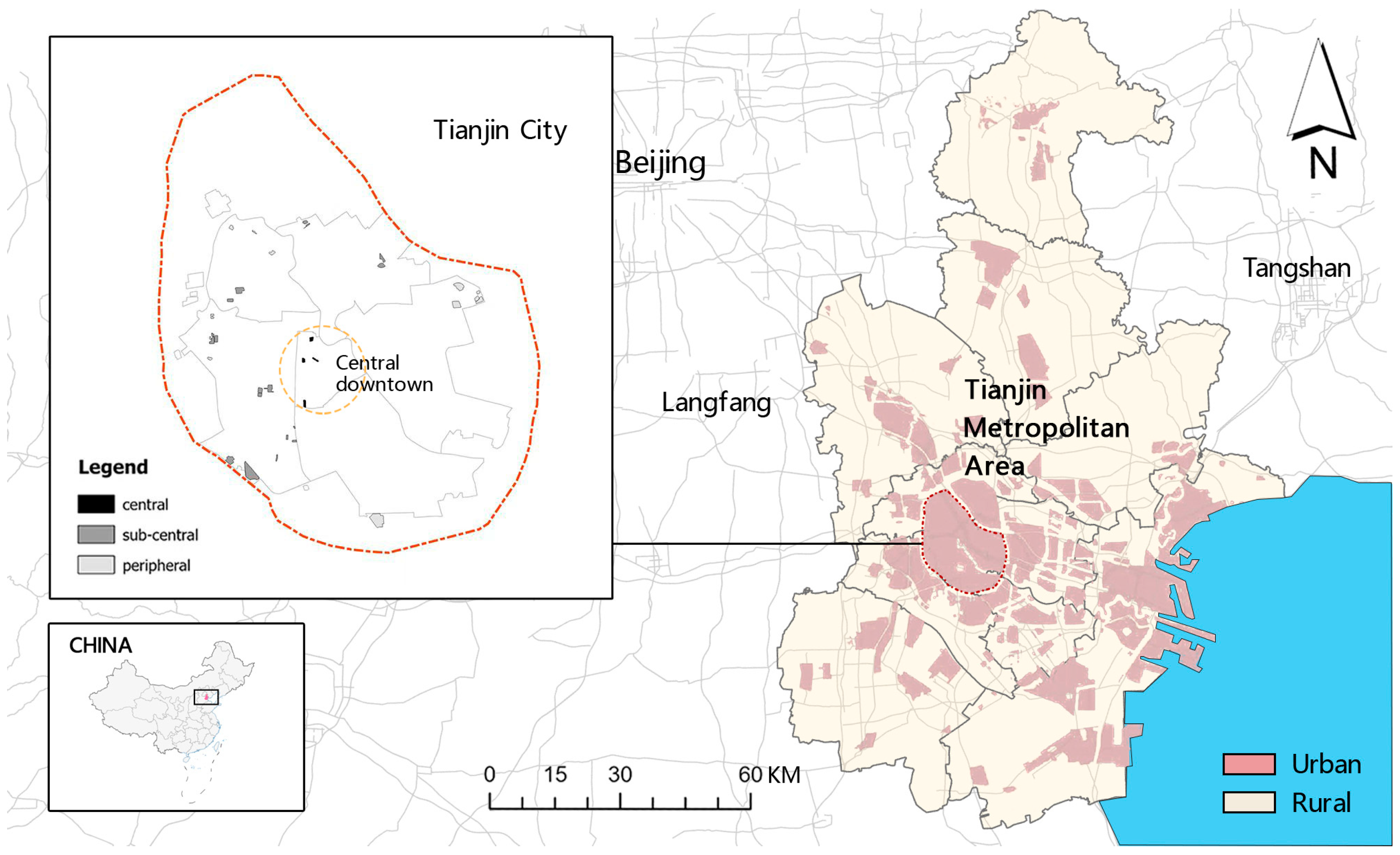

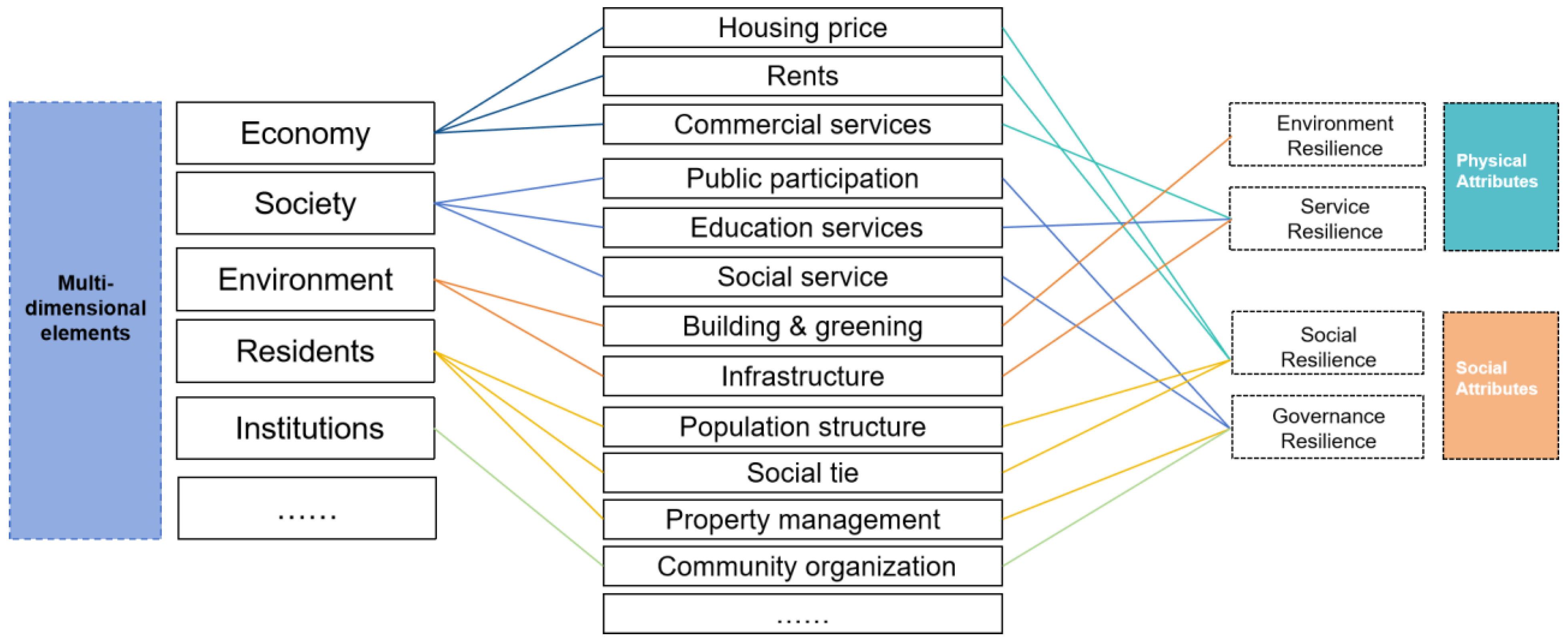
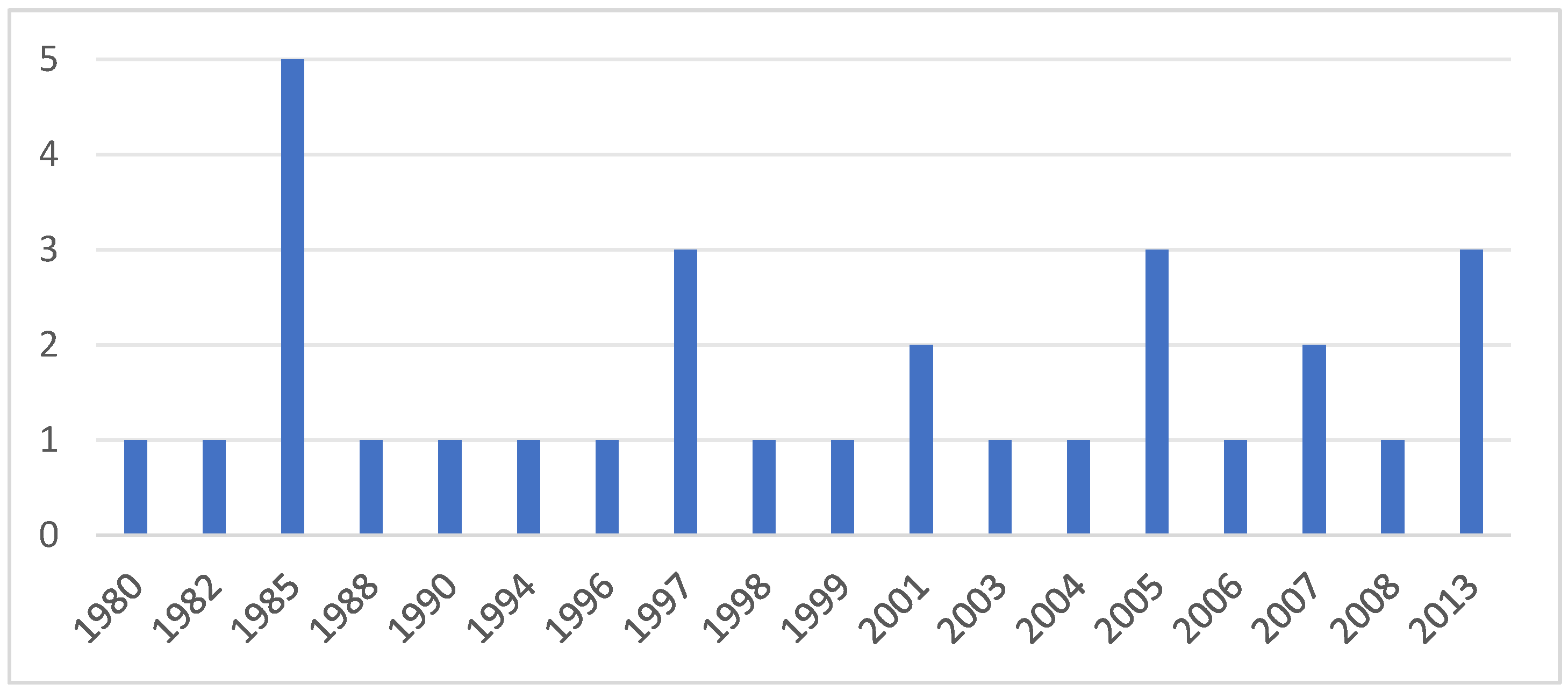
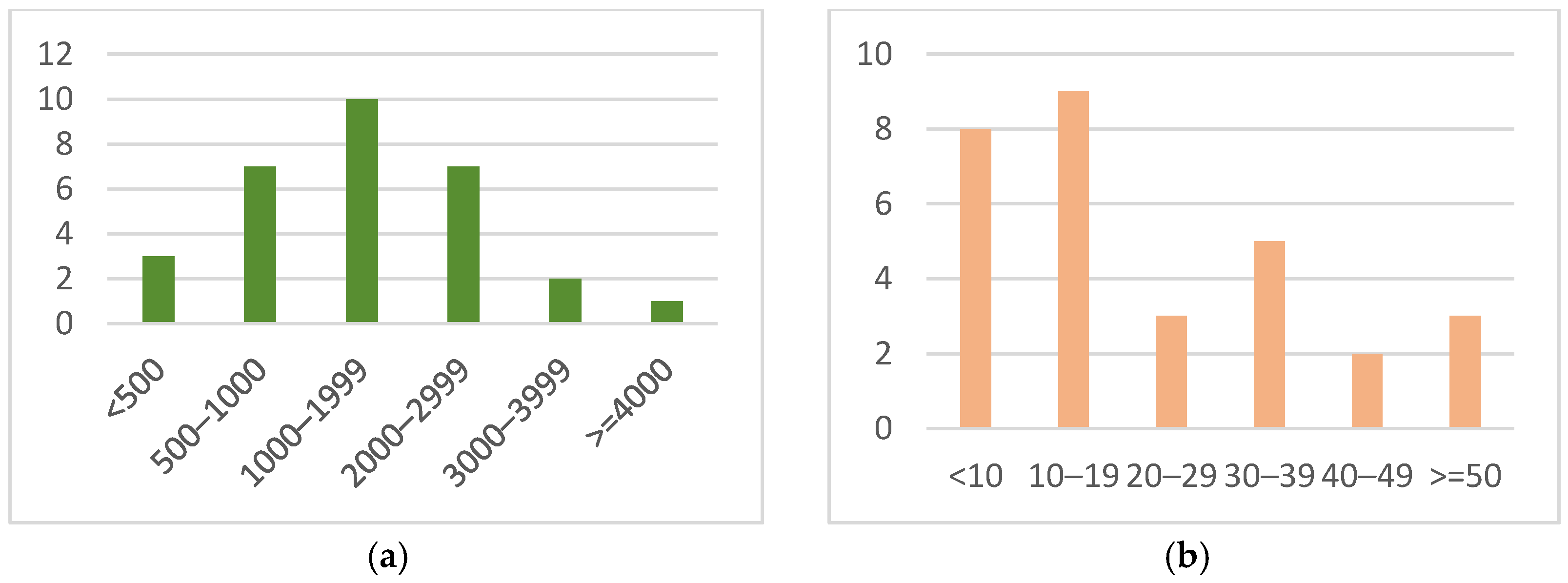

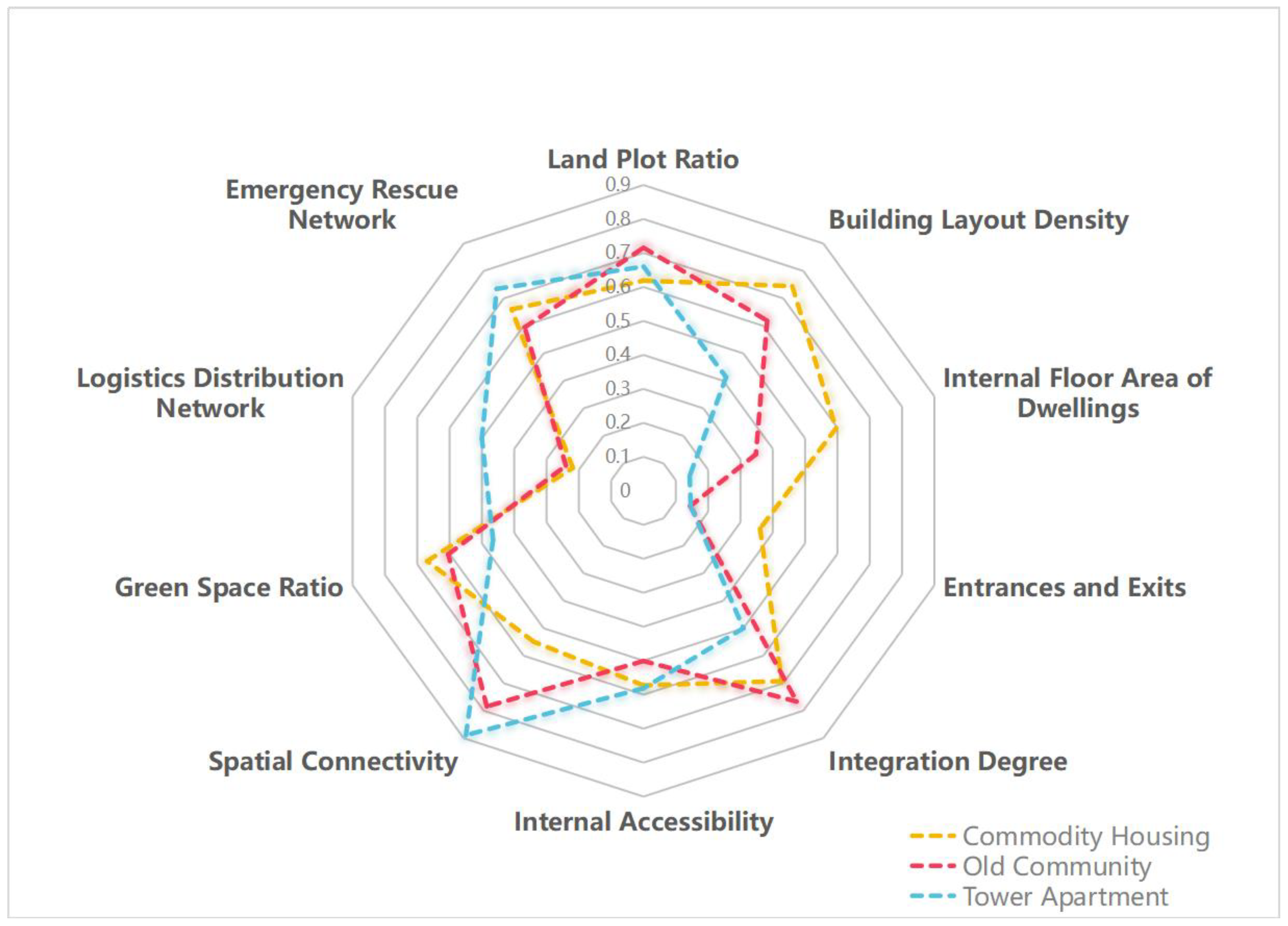

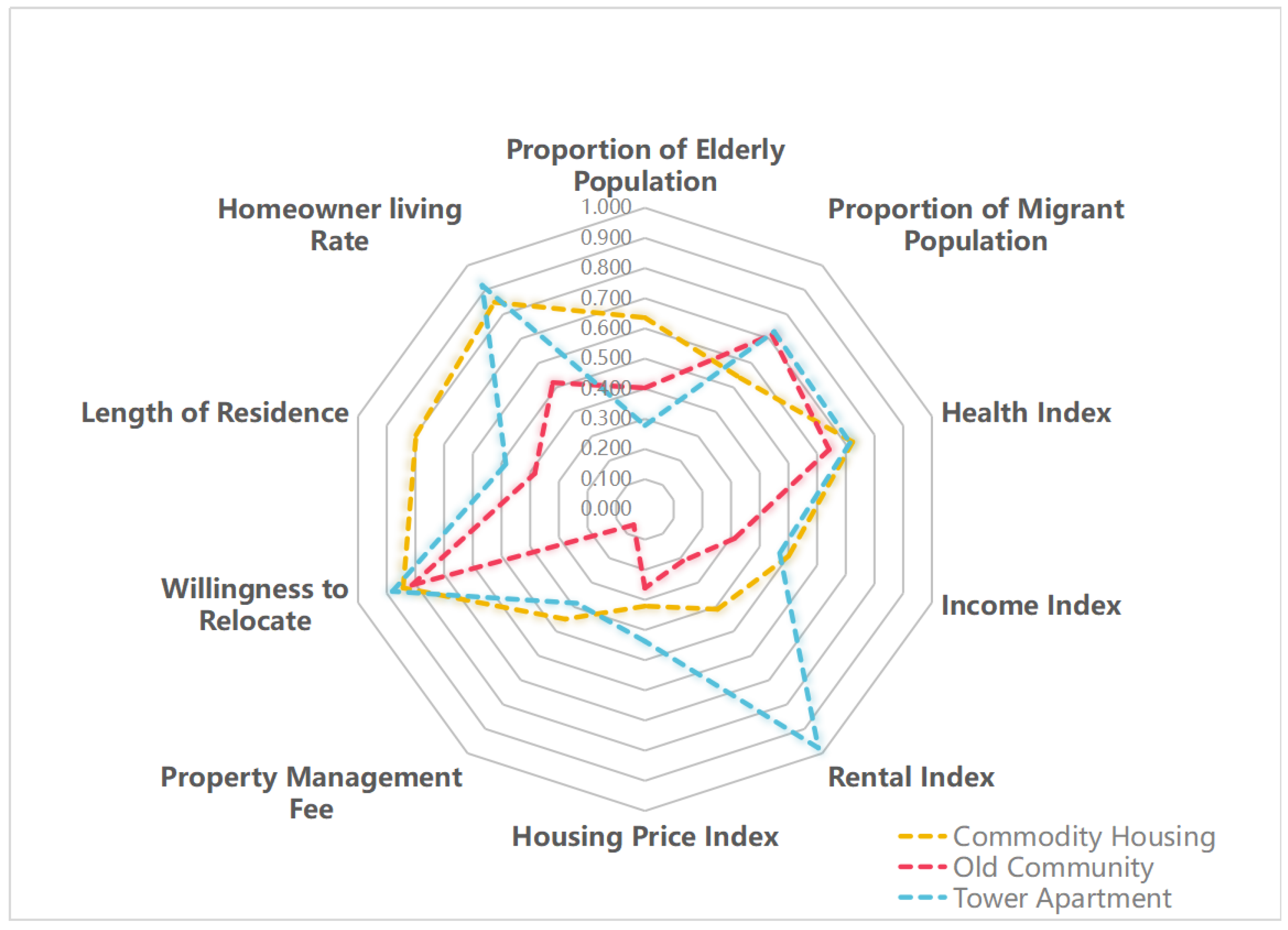

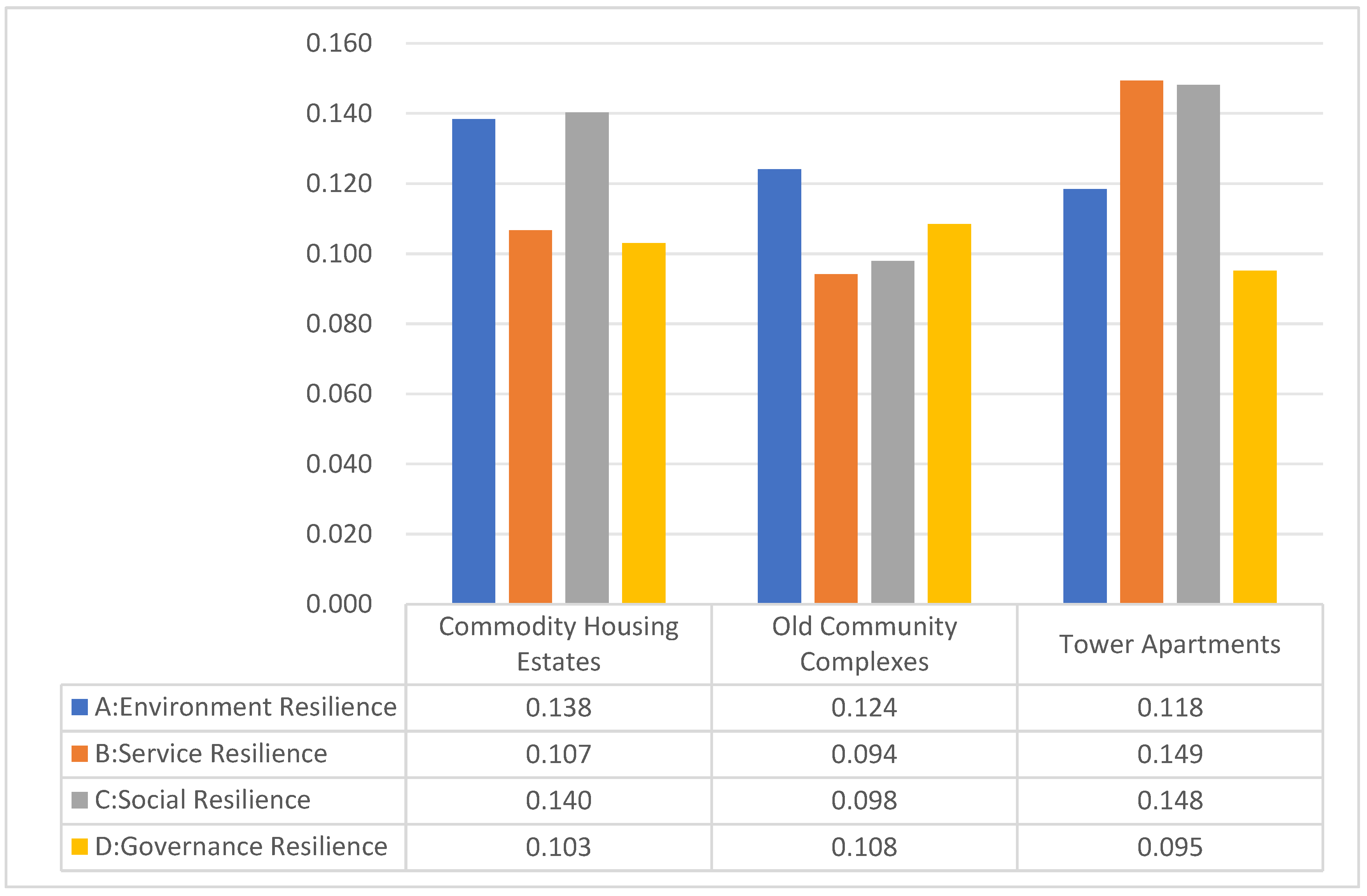


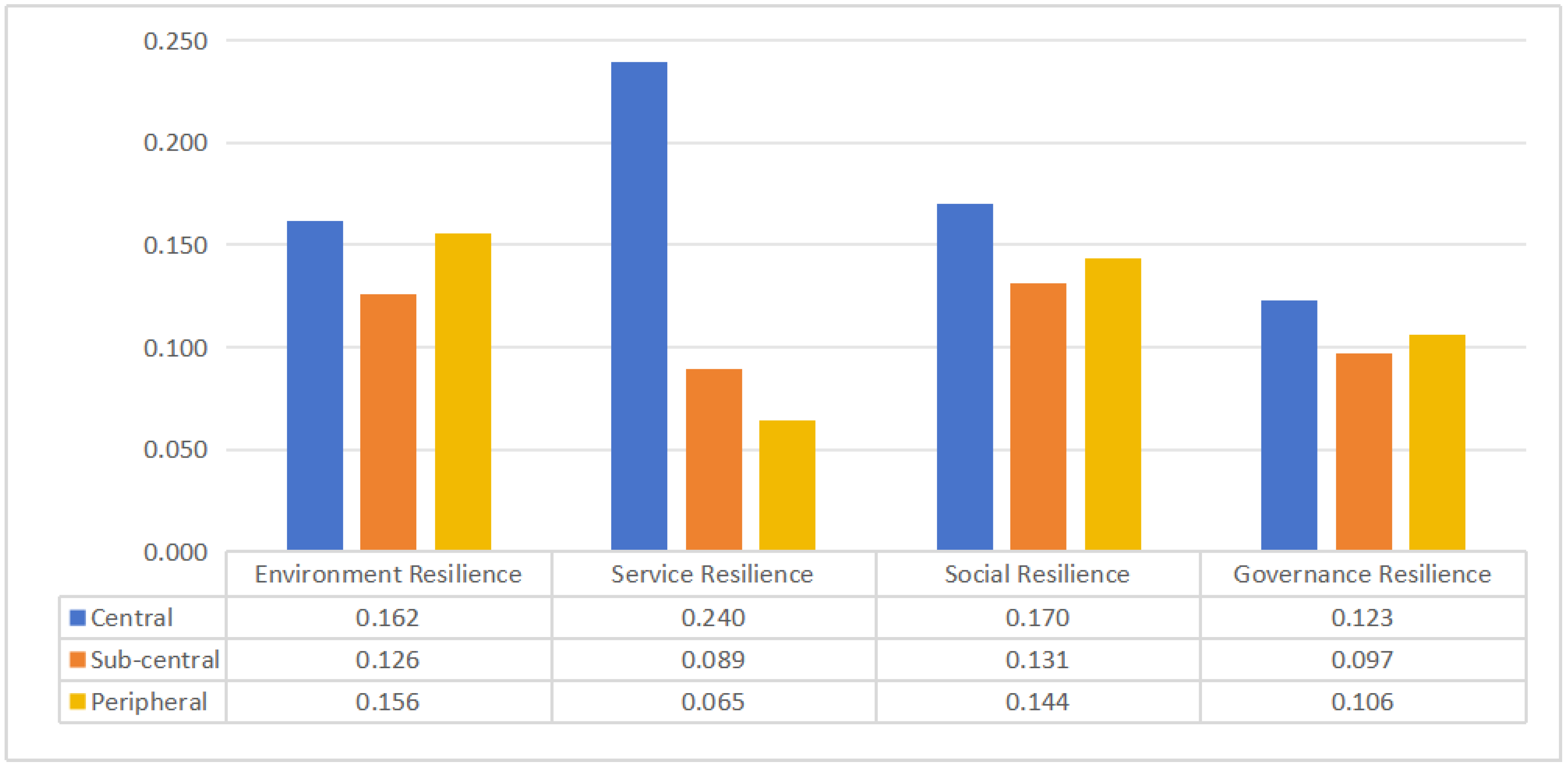

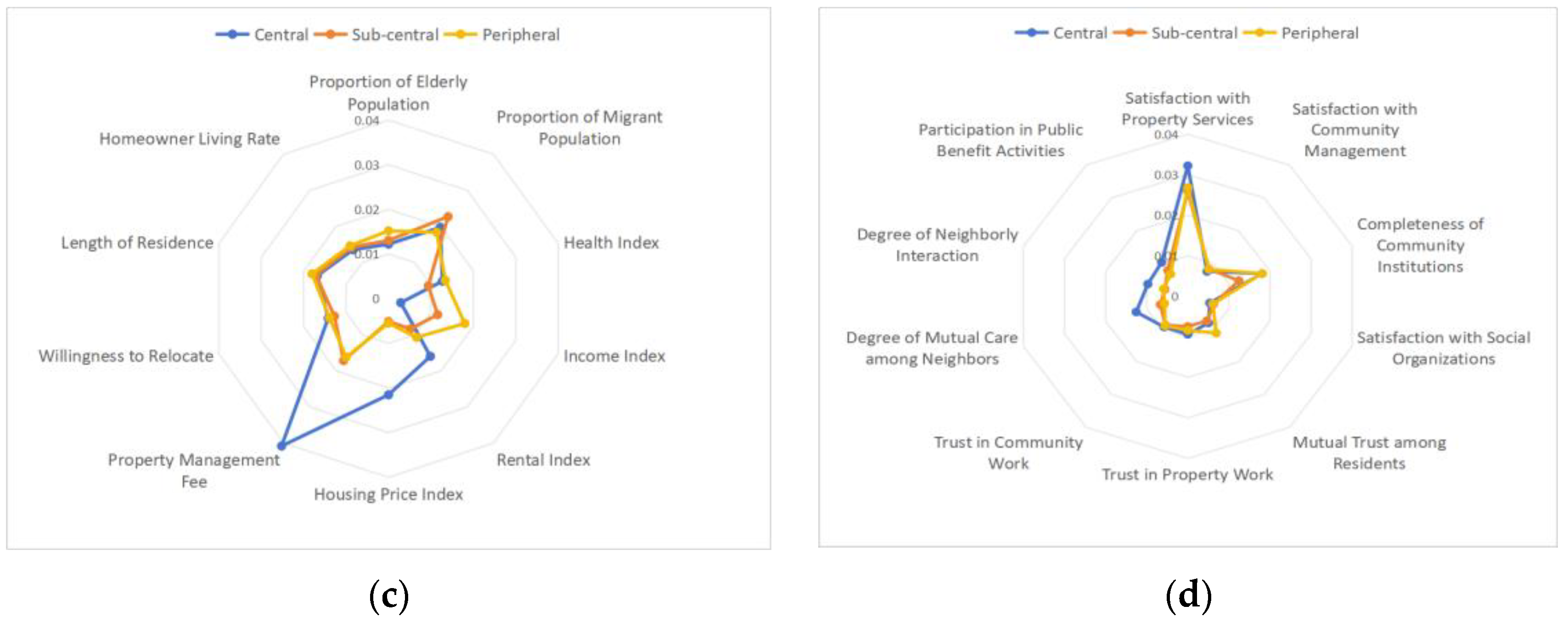
| Literature | Primary Dimensions | Focus |
|---|---|---|
| Norris, F. H.; Stevens, S. P.; Pfefferbaum, B.; Wyche, K. F. (2008) [2] | Economic Development, Social Capital, Information & Communication, Community Competence | Proposes the 4-Dimension-20-Indicator Community Resilience Scale (CD-RISC); emphasizes the integration of pre-disaster capacity and post-disaster adaptation processes. |
| Bruneau, M.; Chang, S. E.; Eguchi, R. T. et al. (2003) [22] | Technical, Organizational, Social, Economic | Engineering-oriented resilience framework focusing on infrastructure performance loss-recovery curves under seismic risk. |
| Cutter, S. L.; Burton, C. G.; Emrich, C. T. (2010) [23] | Social Resilience, Economic Resilience, Institutional Resilience, Infrastructure Resilience, Community Capital Resilience | Serves as baseline indicators for evaluating the effectiveness of resilience projects, policies, and interventions; highlights spatial dimensions. |
| Sutley, E. J.; van de Lindt, J. W.; Peek, L. (2017) [24] | Environmental Resilience, Institutional Resilience, Individual Resilience | Community-based seismic resilience, linking socioeconomic characteristics with engineering building systems. |
| Revell, P.; Henderson, C. (2019) [25] | Economic, Governance, Social, Environmental, Cultural | Validates the “Community Resilience Index (CRI)” across eight EU case studies; emphasizes multi-scale governance and cultural identity. |
| Shen, L.; Tian, Y.; Du, Y. (2021) [26] | Construction Resilience, Social Resilience, Economic Resilience, Organizational Resilience | Targets China’s old residential areas; emphasizes spatial construction and governance dimensions; proposes diversified retrofitting strategies to enhance resilience. |
| Wu, Y.; Zuo, P.; Peng, C.; Zhu, X. (2023) [27] | Economic Resilience, Social Resilience, Facility Resilience, Institutional Resilience, Spatial Resilience, Community Life-Circle Support Resilience | Merges and adapts dimensions within China’s urban community planning context, integrating impacts from public health emergencies. |
| Dong X.; Cai J. (2024) [28] | Institutional resilience, organizational resilience, technology resilience, physical resilience | Institutional, structural, technical and physical factors can enhance or weaken governance performance; a complex heterogeneous connection between the intervention of community social capital and multiple resilience indicators. |
| Environmental Resilience | Measure | Social Resilience | Measure |
|---|---|---|---|
| X1-Land Plot Ratio | Official Statistics | X21-Proportion of Elderly Population | Official Statistics |
| X2-Building Layout Density | Official Statistics | X22-Proportion of Migrant Population | Official Statistics |
| X3-Internal Floor Area of Dwellings | Online Property Statistics | X23-Health Index | Questionnaire |
| X4-Entrances and Exits | Spatial Statistics | X24-Income Index | Official Statistics |
| X5-Road Integration Degree | Space Syntax | X25-Rental Index | Online Property Statistics |
| X6-Internal Accessibility | ArcGIS analysis | X26-Housing Price Index | Online Property Statistics |
| X7-Spatial Accessibility | ArcGIS analysis | X27-Property Management Fee Index | Online Property Statistics |
| X8-Green Space Ratio | Official Statistics | X28-Willingness to Relocate | Questionnaire |
| X9-Logistics Distribution Network | ArcGIS analysis | X29-Length of Residence | Questionnaire |
| X10-Emergency Rescue Network | ArcGIS analysis | X30-Homeowner Living Rate | Official Statistics |
| Service Resilience | Measure | Governance Resilience | Measure |
| X11-Accessibility of Medical Facilities | ArcGIS analysis | X31-Satisfaction with Property Services | Questionnaire |
| X12-Accessibility of Daily Shopping Facilities | ArcGIS analysis | X32-Satisfaction with Community Management | Questionnaire |
| X13-Accessibility of Public Transport | ArcGIS analysis | X33-Completeness of Community Institutions | Questionnaire |
| X14-Accessibility of Cultural Exhibition Facilities | ArcGIS analysis | X34-Satisfaction with Social Organizations | Questionnaire |
| X15-Accessibility of Sports and Fitness Facilities | ArcGIS analysis | X35-Mutual Trust among Residents | Questionnaire |
| X16-Accessibility of Parks and Squares | ArcGIS analysis | X36-Trust in Property Work | Questionnaire |
| X17-Accessibility of Scientific Research and Education Facilities | ArcGIS analysis | X37-Trust in Community Work | Questionnaire |
| X18-Accessibility of Entertainment and Leisure Facilities | ArcGIS analysis | X38-Degree of Mutual Care among Neighbors | Questionnaire |
| X19-Functional Mix Degree of Plots | Spatial Statistics | X39-Degree of Neighborly Interaction | Questionnaire |
| X20-Compliance Rate of Facilities in the 15 min Life Circle | Spatial Statistics | X40-Participation in Public Benefit Activities | Questionnaire |
| Environmental Resilience | AHP Weight | Entropy Weight | Social Resilience | AHP Weight | Entropy Weight |
|---|---|---|---|---|---|
| X1-Land Plot Ratio | 0.0606 | 0.008 | X21-Proportion of Elderly Population | 0.0252 | 0.017 |
| X2-Building Layout Density | 0.0294 | 0.009 | X22-Proportion of Migrant Population | 0.0690 | 0.01 |
| X3-Internal Floor Area of Dwellings | 0.0350 | 0.04 | X23-Health Index | 0.0179 | 0.012 |
| X4-Entrances and Exits | 0.0294 | 0.049 | X24-Income Index | 0.0158 | 0.031 |
| X5-Road Integration Degree | 0.0156 | 0.018 | X25-Rental Index | 0.0202 | 0.029 |
| X6-Internal Accessibility | 0.0138 | 0.016 | X26-Housing Price Index | 0.0111 | 0.037 |
| X7-Spatial Accessibility | 0.0276 | 0.01 | X27-Property Management Fee Index | 0.0324 | 0.059 |
| X8-Green Space Ratio | 0.0269 | 0.012 | X28-Willingness to Relocate | 0.0264 | 0.005 |
| X9-Logistics Distribution Network | 0.0167 | 0.049 | X29-Length of Residence | 0.0293 | 0.014 |
| X10-Emergency Rescue Network | 0.0356 | 0.012 | X30-Homeowner Living Rate | 0.0225 | 0.011 |
| Service Resilience | AHP Weight | Entropy Weight | Governance Resilience | AHP Weight | Entropy Weight |
| X11-Accessibility of Medical Facilities | 0.0254 | 0.021 | X31-Satisfaction with Property Services | 0.0444 | 0.02 |
| X12-Accessibility of Daily Shopping Facilities | 0.0397 | 0.06 | X32-Satisfaction with Community Management | 0.0190 | 0.016 |
| X13-Accessibility of Public Transport | 0.0347 | 0.019 | X33-Completeness of Community Institutions | 0.0172 | 0.019 |
| X14-Accessibility of Cultural Exhibition Facilities | 0.0101 | 0.052 | X34-Satisfaction with Social Organizations | 0.0130 | 0.008 |
| X15-Accessibility of Sports and Fitness Facilities | 0.0123 | 0.054 | X35-Mutual Trust among Residents | 0.0243 | 0.016 |
| X16-Accessibility of Parks and Squares | 0.0139 | 0.06 | X36-Trust in Property Work | 0.0172 | 0.01 |
| X17-Accessibility of Scientific Research and Education Facilities | 0.0127 | 0.037 | X37-Trust in Community Work | 0.0163 | 0.014 |
| X18-Accessibility of Entertainment and Leisure Facilities | 0.0096 | 0.063 | X38-Degree of Mutual Care among Neighbors | 0.0276 | 0.021 |
| X19-Functional Mix Degree of Plots | 0.0415 | 0.014 | X39-Degree of Neighborly Interaction | 0.0173 | 0.014 |
| X20-Compliance Rate of Facilities in the 15 min Life Circle | 0.0280 | 0.024 | X40-Participation in Public Benefit Activities | 0.0151 | 0.01 |
| Analysis of Resilience of Communities to Disasters (ARC-D) | Baseline Resilience Indicators for Communities (BRIC) | Community Disaster Resilience Planning (CDRP) | Urban Community Resilience Assessment (UCRA) | |
|---|---|---|---|---|
| Region/Organization | International Humanitarian Emergency Agency | Research Institute from University of South Carolina | Justice Institute of British Columbia, Canada | University and research institution joint research Team |
| Objective | Identify community disaster-resistance capacity | Monitor county-level resilience to natural disasters | Provide a planning framework for community disaster response | Detect gaps through assessment and carry out targeted interventions to enhance community resilience |
| Content | 1. Build community database 2. Evaluate the level of community disaster response | 1. Use resilience indicators to compare county-level resilience 2. Conduct a community resilience assessment every five years to understand the improvement of community resilience | 1. Provide community feature information and boundaries to assist in collecting community information 2. Develop community hazard risk analysis tools to calculate community disaster resilience indices. | 1. Integrate community basic information data, spatial basic data, survey questionnaires and other multi-source data ledger 2. Visualize the shortcomings of community infrastructure, services, and governance 3. Clarify the direction of action for enhancing community resilience |
| Key dimensions & Indicators | Education, health, economy, society (30 indicators) | Human well-being, economy, community capital, institutions, infrastructure, environment (50 indicators) | Community resources, disaster management (265 indicators) | Environment, service, social and governance (40 indicators) |
| Application Areas | South America, North America, Africa | U.S. mainland, Alaska, Hawaii | Communities in Canada | Urban neighborhoods within built-up areas of Chinese cities |
| Technology-Policy Integration | Bottom-up policy support for local governments | Collect annual data to guide public-health emergency planners | Government-funded project actively engaging social capital (Vancouver Foundation) | Co-governance model aimed at renewal and governance enhancement |
Disclaimer/Publisher’s Note: The statements, opinions and data contained in all publications are solely those of the individual author(s) and contributor(s) and not of MDPI and/or the editor(s). MDPI and/or the editor(s) disclaim responsibility for any injury to people or property resulting from any ideas, methods, instructions or products referred to in the content. |
© 2025 by the authors. Licensee MDPI, Basel, Switzerland. This article is an open access article distributed under the terms and conditions of the Creative Commons Attribution (CC BY) license (https://creativecommons.org/licenses/by/4.0/).
Share and Cite
Wang, Y.; Du, X.; Zhang, L.; Zhang, Z.; Sun, X.; Wang, Y.P. Typology-Driven Urban Community Resilience Assessment in China: Spatial Disparities and Smart Transformation Roadmaps. Buildings 2025, 15, 3961. https://doi.org/10.3390/buildings15213961
Wang Y, Du X, Zhang L, Zhang Z, Sun X, Wang YP. Typology-Driven Urban Community Resilience Assessment in China: Spatial Disparities and Smart Transformation Roadmaps. Buildings. 2025; 15(21):3961. https://doi.org/10.3390/buildings15213961
Chicago/Turabian StyleWang, Yu, Xintian Du, Linyu Zhang, Zhijun Zhang, Xuan Sun, and Ya Ping Wang. 2025. "Typology-Driven Urban Community Resilience Assessment in China: Spatial Disparities and Smart Transformation Roadmaps" Buildings 15, no. 21: 3961. https://doi.org/10.3390/buildings15213961
APA StyleWang, Y., Du, X., Zhang, L., Zhang, Z., Sun, X., & Wang, Y. P. (2025). Typology-Driven Urban Community Resilience Assessment in China: Spatial Disparities and Smart Transformation Roadmaps. Buildings, 15(21), 3961. https://doi.org/10.3390/buildings15213961






